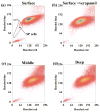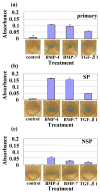Identification of superficial zone articular chondrocyte stem/progenitor cells
- PMID: 17482567
- PMCID: PMC2583246
- DOI: 10.1016/j.bbrc.2007.04.142
Identification of superficial zone articular chondrocyte stem/progenitor cells
Abstract
Identification of progenitor/stem cell populations that differentiate specifically towards superficial zone articular chondrocytes is an unmet challenge for cartilage tissue engineering. Using fluorescence activated cell sorting (FACS) analysis we found a characteristic pattern of "side population" (SP) stem cells identified by the Hoechst 33342 dye. We established micromass cultures from this population of cells and tested their chondrogeneic potential. Control (untreated) cultures were minimally stained for Alcian blue - a marker of chondrogenesis. However, with BMP-7 treatment, Alcian blue staining was increased. Superficial zone protein - a specific marker for articular cartilage superficial zone chondrocytes - increased with BMP-7 and/or TGF-beta1 treatment in SP micromass cultures. Our results demonstrate the presence of stem/progenitor cells in the SP fraction isolated from the surface zone of bovine cartilage and have the ability to specifically differentiate towards the superficial zone articular chondrocyte.
Figures




References
-
- Hayes AJ, MacPherson S, Morrison H, Dowthwaite G, Archer CW. The development of articular cartilage: evidence for an appositional growth mechanism. Anat Embryol (Berl) 2001;203:469–79. - PubMed
-
- Dowthwaite GP, Bishop JC, Redman SN, Khan IM, Rooney P, Evans DJ, Haughton L, Bayram Z, Boyer S, Thomson B, Wolfe MS, Archer CW. The surface of articular cartilage contains a progenitor cell population. J Cell Sci. 2004;117:889–97. - PubMed
-
- Martin JM, Smith M, Al-Rubeai M. Cryopreservation and in vitro expansion of chondroprogenitor cells isolated from the superficial zone of articular cartilage. Biotechnol Prog. 2005;21:168–77. - PubMed
-
- Bunting KD. ABC transporters as phenotypic markers and functional regulators of stem cells. Stem Cells. 2002;20:11–20. - PubMed
Publication types
MeSH terms
Substances
Grants and funding
LinkOut - more resources
Full Text Sources
Medical

